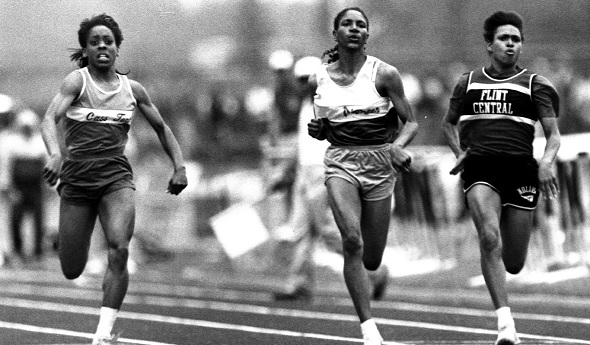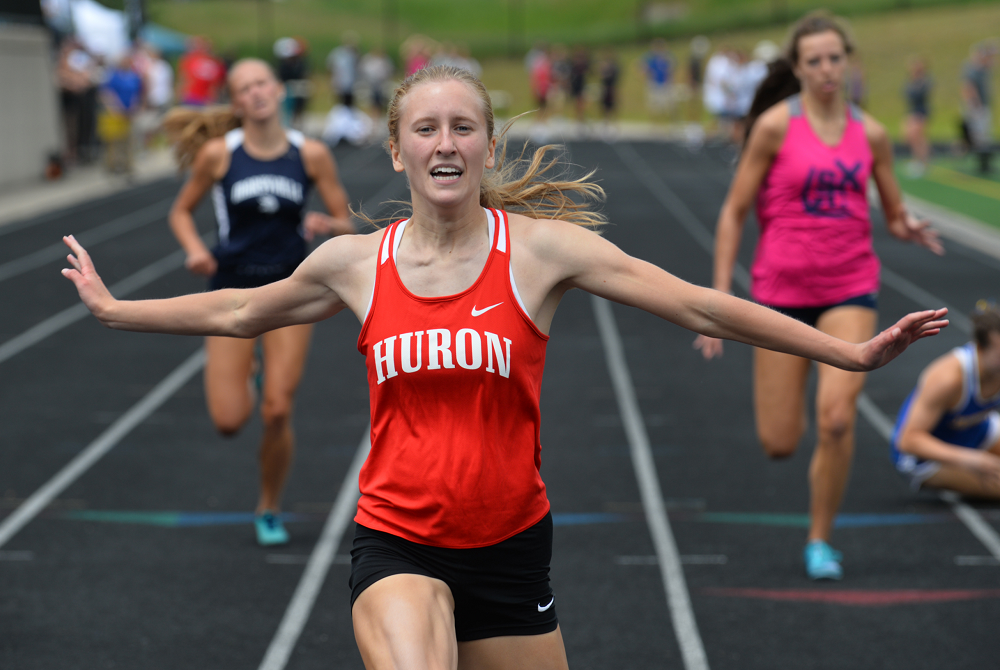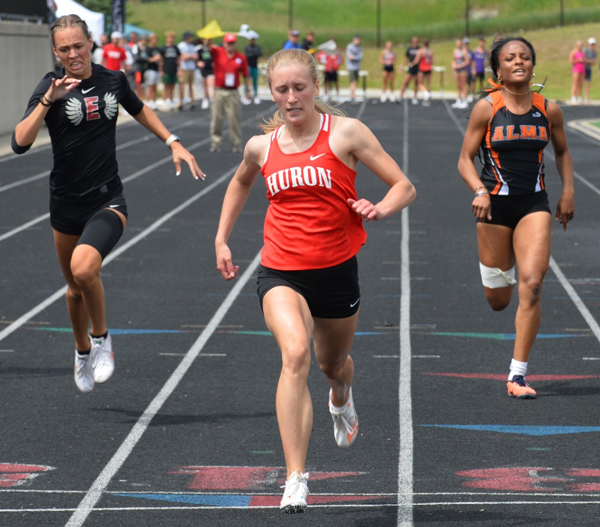
#TBT: Pioneer Bests Impressive Field
By
Geoff Kimmerly
MHSAA.com senior editor
May 22, 2014
Ann Arbor Pioneer owns an MHSAA-best 16 team championships in girls track and field, including a string of seven straight won in Class A from 1985-91.
The Pioneers answered arguably their toughest challenge of that run in 1989, against a Detroit Cass Tech team featuring a record-setting long jumper and a sprint field that remains one of the most star-studded in MHSAA Finals history.
Pioneer won the June 3, 1989, meet at Eastern Michigan University with 70.5 points to Cass Tech’s 58 and Flint Central’s 33.5. The main event for the second straight season was the 100-meter championship race matching the standout athletes from all three top-placing teams.
Repeating their finish in the race from 1988, Pioneer’s Crystal Braddock (11.84) outlasted Central’s Patrice Verdun (11.99) and Cass Tech’s Trinette Johnson (12.10) to cross the line first.
Braddock also won the 200 and ran on the victorious 1,600 relay at the 1989 Final, and finished her high school career with four individual and three relays championships. Verdun also finished runner-up to Braddock in the 200 in 1989, but did win the 100 as both a freshman and sophomore in 1986 and 1987, respectively.
Johnson ran on the winning 400 relay, but left her lasting mark by claiming the long jump title in 19 feet, 8 inches – an MHSAA all-Finals record that continues to stand and was nearly 20 inches longer than the runner-up that day. Johnson also won the long jump the previous spring as a junior. Cass Tech finished runner-up six times during Pioneer's seven-season title string.
High school was just the start of the trio’s track and field successes. Braddock went on to run at the University of Texas, earning All-America honors four times and helping set a relay record at the World University Games. Verdun and Johnson ran together at Florida State, teaming up on relays that earned them All-America honors. Verdun earned All-America five times for the Seminoles, and Johnson was a six-time All-American, including four times for long jump.
Click to see results from the 1989 LP Class A Final.
PHOTO: (Left to right) Detroit Cass Tech’s Trinette Johnson, Ann Arbor Pioneer’s Crystal Braddock and Flint Central’s Patrice Verdun head toward the finish line during the 100-meter championship race at the 1989 MHSAA Class A Lower Peninsula Final.

Multi-Sprint Champ Racing to Finish Huron Career Ahead of the Rest Again
By
Keith Dunlap
Special for MHSAA.com
May 25, 2023
NEW BOSTON – If there was one thing Elizabeth Anderson took pride in elementary school, it was simply showing that she could outrun everyone in sight.
 In fact, Anderson has an explanation for all the success she had in those playground races.
In fact, Anderson has an explanation for all the success she had in those playground races.
“Dominance when you are in elementary school,” Anderson quipped. “I don’t think I ever had a nickname. I just think everyone knew I was fast.”
Years later, pretty much everyone who follows track & field in the state of Michigan can attest to that.
A senior for New Boston Huron, Anderson has been faster than most other competitors in the state during her three-year high school career (with her freshman season in 2020 canceled due to COVID-19).
Last year, Anderson won titles at the Lower Peninsula Division 2 Finals in the 200-meter (25.07) and 400-meter (56.28) dashes, and was runner-up in the 100-meter dash (12.23).
Often, top sprinters focus on one or two of those three races. But Anderson is certainly a different breed of sprinter because she does all three.
In fact, she holds school records in all three of those events, and if all that weren’t enough, Anderson is a part of all three sprint relay teams.
“It is hard to give her events off,” said New Boston Huron head girls track coach Danielle Lobato.
Despite the different styles the 100, 200 and 400-meter dashes present, Anderson said there usually isn’t much adjusting when she goes from one of those races to another.
 The strategy is simply, “Let’s beat the other girls to the finish line.”
The strategy is simply, “Let’s beat the other girls to the finish line.”
“I don’t really go into each race changing up how I would run,” she said.
While enjoying and succeeding in all three races, Anderson said she actually does have a favorite among them.
“I would say the 400 is probably my favorite,” she said. “Even though it hurts, it’s satisfying to see how much you can get your time down in the 400 compared to any other race.”
Anderson said she started running track in sixth grade, but really got serious about it during the summer after her sophomore season, when she was invited to run for a local club.
Eventually, that led to her competing over the winter in indoor events.
She lived and breathed track so much that last fall, she decided to not run cross country so she could focus on a weightlifting regimen aimed at developing more leg strength.
“Once I started doing summer track, I realized I wanted to be doing this all the time,” she said.
Lobato said oftentimes in practice, Anderson is a de facto coach, given there is no better person she can think of for the younger runners on the team to learn from.
“I can’t always demonstrate these things I’m trying to teach,” she said. “You get to see it in real life (from Anderson), not in a YouTube video.”
After winning the 100, 200 and 400-meter dashes at her Regional meet last week, Anderson has her sights set on achieving the same trifecta of titles at next Saturday’s Finals in Grand Rapids.
Anderson has signed to run track at Michigan State, but has been plenty motivated to keep producing this spring in her final high school season.
“I’m really looking to defend my titles,” she said. “That is what is really motivating me to keep going. I want to keep in shape for the college season. I don’t want to lose any of the progress I have made. Ultimately, I just love running track.”
And since elementary school, Anderson has loved — and succeeded in — outrunning everyone else to the finish line.
“We knew we were getting something special,” Lobato said of when Anderson arrived in high school. “But you never expect this. All that she has accomplished is amazing.”
 Keith Dunlap has served in Detroit-area sports media for more than two decades, including as a sportswriter at the Oakland Press from 2001-16 primarily covering high school sports but also college and professional teams. His bylines also have appeared in USA Today, the Washington Post, the Detroit Free Press, the Houston Chronicle and the Boston Globe. He served as the administrator for the Oakland Activities Association’s website from 2017-2020. Contact him at [email protected] with story ideas for Oakland, Macomb and Wayne counties
Keith Dunlap has served in Detroit-area sports media for more than two decades, including as a sportswriter at the Oakland Press from 2001-16 primarily covering high school sports but also college and professional teams. His bylines also have appeared in USA Today, the Washington Post, the Detroit Free Press, the Houston Chronicle and the Boston Globe. He served as the administrator for the Oakland Activities Association’s website from 2017-2020. Contact him at [email protected] with story ideas for Oakland, Macomb and Wayne counties
PHOTOS (Top) New Boston Huron's Elizabeth Anderson clears the finish line during last season's LPD2 400 race. (Middle) Anderson, middle, outpaces the field to also win the 200. (Click for more from RunMichigan.com.)

